In a landmark development for enterprise data management, DevRev, a San Francisco-based pioneer in AI-driven solutions, has unveiled a transformative integration with Microsoft Fabric, announced on November 18 of this year. This strategic partnership merges the capabilities of DevRev’s AI-native platform with Microsoft Fabric’s robust data framework, particularly through Microsoft OneLake, a unified data lake designed for enterprise analytics and AI applications. The primary goal of this collaboration is to address the pervasive issue of fragmented data sources by creating a cohesive, singular source of truth for businesses. By seamlessly connecting the extensive data repository of Microsoft OneLake with DevRev’s specialized customer and product insights, this integration promises to revolutionize how enterprises harness information for decision-making. The implications are profound, as it not only enhances AI-driven processes but also streamlines workflows across diverse business functions. The excitement surrounding this announcement stems from its potential to break down long-standing data silos, enabling teams to access actionable insights with unprecedented ease. For companies already invested in Microsoft technologies, this development offers a pathway to leverage cutting-edge AI without necessitating a complete system overhaul. This article delves into the intricacies of this collaboration, examining its technological foundations, the tangible benefits it offers to enterprises, and its alignment with broader industry movements toward data unification and AI adoption.
Breaking Down Data Barriers
The core mission of this integration is to dismantle the persistent challenge of data silos that plague many enterprises today. Modern businesses often grapple with information scattered across numerous applications and systems, making it difficult to achieve a comprehensive understanding of operations. By linking Microsoft OneLake’s vast data storage capabilities with DevRev’s proprietary knowledge graph, this partnership facilitates a smooth and efficient flow of information. This unified data hub transcends traditional boundaries, ensuring that analytics, customer operations, and product development teams can access a shared, holistic view of organizational data. Such connectivity is vital for enabling quicker, more informed decisions in a fast-paced business environment. The ability to centralize disparate datasets into a single repository means that enterprises no longer need to piece together fragmented insights, which often leads to inefficiencies and errors. Instead, a streamlined data foundation empowers teams to focus on strategic initiatives rather than data reconciliation.
Beyond merely connecting data sources, this integration significantly enhances the contextual depth available to AI systems. When AI agents can access a broader, more interconnected dataset, the insights they generate become far more accurate and relevant. For instance, combining customer feedback stored in DevRev’s platform with operational metrics from Microsoft OneLake allows AI to identify patterns and suggest actionable improvements with precision. This enriched context is particularly crucial for organizations operating in dynamic markets where agility and responsiveness are key differentiators. The impact extends to various functions, from marketing teams tailoring campaigns based on real-time data to product managers prioritizing features based on integrated user insights. This level of data unification ensures that AI-driven solutions are not just reactive but proactively aligned with business needs, setting a new standard for enterprise intelligence.
Engineering a Seamless Technological Alliance
At the technological heart of this collaboration lies DevRev’s innovative AI teammate, known as Computer, paired with its patented synchronization engine, Computer AirSync. These advanced tools are designed to extract data from Microsoft OneLake and integrate it securely with DevRev’s permission-aware knowledge graph. This graph organizes data in a manner that preserves context and enforces strict access controls, safeguarding sensitive information while still making it available for AI-driven analysis. The creation of a cross-application data hub through this integration serves as a central pillar for enterprise intelligence, enabling a level of interoperability that was previously challenging to achieve. The meticulous engineering behind this setup ensures that data flows effortlessly between systems, providing a robust foundation for analytics and operational workflows. This technological synergy addresses critical interoperability issues that often hinder enterprise efficiency.
Microsoft OneLake, a key component of Microsoft Fabric, further amplifies the power of this integration by consolidating both structured and unstructured data from diverse sources within an enterprise. When paired with DevRev’s syncing capabilities, it forms a comprehensive dataset that AI agents can leverage for deeper, more meaningful insights. Consider the potential of an AI system analyzing customer interaction data alongside sales performance metrics to recommend targeted product enhancements—a process that would be cumbersome and error-prone without such a unified approach. This collaboration showcases how innovative engineering can resolve complex data challenges, ensuring that enterprises can maximize the value of their information assets. The seamless data flow enabled by this partnership not only enhances analytical capabilities but also supports real-time decision-making across various business units, marking a significant leap forward in technological integration.
Transformative Benefits for Enterprise Operations
The advantages of this integration for enterprises are both extensive and multifaceted, offering immediate value across several dimensions. One of the most significant benefits is the provision of unified analytics, where disparate datasets are merged into a single, actionable perspective. This is especially beneficial for organizations with intricate structures, where data often resides in isolated pockets, inaccessible to teams that need it most. With a consolidated view, businesses can monitor operations holistically, identifying trends and inefficiencies that might otherwise go unnoticed. Customer support teams, for example, gain the ability to address inquiries with greater accuracy by referencing a combination of historical interactions and broader enterprise data. This unified approach reduces response times and improves service quality, directly impacting customer satisfaction and retention.
Another critical advantage lies in fostering cross-functional collaboration by eliminating data barriers between departments. Analytics, customer support, and product development teams can now operate on a shared data foundation, reducing miscommunication and streamlining workflows. This integration also protects existing investments in Microsoft technologies, allowing enterprises to adopt AI-native solutions without the need for disruptive overhauls. For Microsoft-centric businesses, this represents a competitive edge, positioning them as frontrunners in AI adoption within their respective industries. The ability to enhance current systems with cutting-edge capabilities ensures that organizations remain agile and innovative without sacrificing stability. This partnership sets a benchmark for how strategic collaborations can deliver transformative value, demonstrating that data-centric solutions are essential for staying ahead in a rapidly evolving business landscape.
Aligning with Industry Trends and Future Potential
This integration aligns closely with overarching industry trends toward data centralization and the widespread adoption of AI technologies. Enterprises across sectors are increasingly recognizing the necessity of consolidating fragmented data sources into unified platforms to drive actionable insights. The complexity of modern business operations, coupled with the demand for real-time decision-making, has made solutions like this integration indispensable. Microsoft OneLake’s role as a unified data lake exemplifies the industry’s push toward scalable analytics and AI initiatives, providing a foundation that supports expansive data strategies. By incorporating DevRev’s AI-native capabilities, this partnership enhances the potential for automation and intelligence in workflows, reflecting a broader shift toward leveraging contextual data for operational excellence.
Looking ahead, the collaboration between DevRev and Microsoft Fabric serves as a compelling case study for how technology providers can unite to address critical enterprise needs. The success of this integration could inspire similar partnerships across the tech ecosystem, encouraging innovation in data management and AI application. For Microsoft-centric enterprises, the value proposition is particularly strong, offering a pathway to compete in an increasingly AI-driven marketplace. The emphasis on enhancing AI context through interconnected data also underscores the growing importance of comprehensive integration in business intelligence. As AI continues to permeate various aspects of operations—from predictive analytics to customer engagement—the need for such unified platforms will only intensify, positioning this partnership as a forward-thinking solution with lasting impact.
Reflecting on a Milestone in Enterprise Intelligence
Looking back, the announcement of the integration between DevRev and Microsoft Fabric on November 18 marked a defining moment in the evolution of enterprise data management. The successful merging of Microsoft OneLake’s extensive data capabilities with DevRev’s specialized customer and product datasets through advanced synchronization and knowledge graph technologies tackled the longstanding issue of data fragmentation head-on. The resulting benefits, which spanned unified analytics, improved AI responses, and enhanced cross-platform collaboration, underscored the transformative power of this alliance. Insights from leadership at both companies further highlighted the strategic vision behind breaking down data barriers and accelerating AI initiatives. As a step forward, enterprises are encouraged to explore how this integration can be tailored to their specific needs, potentially integrating additional datasets or customizing AI applications for unique challenges. Additionally, staying attuned to emerging partnerships in the tech space could uncover further opportunities to enhance data strategies. This collaboration not only delivered immediate value but also laid the groundwork for future innovations, offering a model for how unified data and AI can drive sustained business success in a complex digital landscape.









